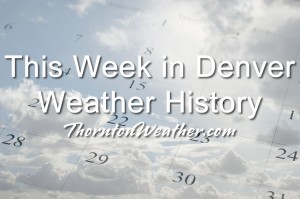
January is not usually particularly snowy and as our look back at this week in Denver weather history shows, it is wind and extreme cold that are the most notable conditions during the period.
From the National Weather Service:
10-11 in 1948…strong winds were reported in Boulder and Lakewood. Winds of 50 to 60 mph were reported at Valmont…just east of Boulder. Only minor damage was reported.
In 1980…strong winds of 60 to 95 mph howled across metro Denver…causing some brief power outages and some broken windows. A wind gust to 111 mph was recorded at Wondervu. Northwest winds gusted to 40 mph at Stapleton International Airport on the 10th.
In 1999…high winds gusting to 100 mph blasted the foothills. Peak wind gusts included: 100 mph at central city…98 mph at Wondervu…82 mph at Aspen Springs and Golden Gate Canyon… 81 mph at the NCAR Mesa Lab in Boulder and near Nederland… 78 mph atop Blue Mountain near Coal Creek Canyon…and 72 mph at the Rocky Flats Environmental Test Facility. West winds gusted to 38 mph and warmed the temperature to a high of 63 degrees at Denver International Airport on the 11th.
10-12
In 1997…heavy snow fell over the Front Range foothills. A foot of new snow was measured at Blackhawk with 7 inches recorded in Coal Creek Canyon. Only 3.3 inches of snow fell at the site of the former Stapleton International Airport. East-northeast winds gusted to 18 mph at Denver International Airport on the 11th.
10-13
In 1963…a arctic cold wave plunged temperatures well below zero across metro Denver. Temperatures were below zero for a total of 64 consecutive hours. Low temperatures reached 25 degrees below zero on both the 11th and 12th. The high temperature of 9 degrees below zero on the 11th was the coldest ever recorded at Stapleton Airport and equaled the record low maximum for the month first set on January 19…1883…in downtown Denver. The high temperature on the 12th reached only 1 degree below zero. On the 12th…an 18-year-old youth died of exposure from the extreme cold in Denver. There were many losses and damage to property from frozen water systems…stalled cars…and over-burdened heating systems. Light snow accompanied the arctic blast. At Stapleton Airport…2.3 inches of snow fell on the 10th and 11th.
11
In 1887…northwest winds were sustained to 40 mph in the city.
In 1893…northwest winds to 48 mph were recorded in the city.
In 1901…northwest winds were sustained to 45 mph with an extreme velocity of 47 mph.
In 1988…strong Chinook winds blew throughout the day along the eastern foothills. Winds peaked to 75 mph in Boulder… Breaking at least one window. West winds gusted to 49 mph at Stapleton International Airport.
In 1989…2 to 3 inches of snow fell across metro Denver causing near gridlock conditions during the morning rush hour and two-hour delays at Stapleton International Airport. Two to 6 inches of snow whitened Boulder where many traffic accidents were reported. Snowfall measured 2.9 inches at Stapleton International Airport where northeast winds gusted to 21 mph.
In 1995…high winds developed in the foothills. A gust to 67 mph was recorded at Rocky Flats in northern Jefferson County. West winds gusted to only 32 mph at Stapleton International Airport.
In 1996…very strong winds were reported in the Front Range foothills for a brief time. Wind gusts to 85 mph were recorded at Golden Gate Canyon…with 95 mph at Wondervu.
11-12
In 1972…high winds howled along the Front Range foothills. A wind gust to 144 mph was recorded at the National Center for Atmospheric Research in Boulder. A wind gust to 105 mph was recorded at the Rocky Flats plant south of Boulder. Wind gusts to 90 mph were recorded in downtown Boulder. The greatest damage from the windstorm occurred in Boulder where 25 or more mobile homes were destroyed either by wind or the fires which resulted when they were overturned. Car windows were blown out; many buildings damaged; utility poles…power lines…trees…and traffic lights blown down. As many as 75 families were evacuated from a recently completed apartment building because of severe structural damage. Government and private office buildings and industrial plants were evacuated because of danger from flying glass and debris. Twelve people were treated at the hospital…mostly for cuts from flying glass. At least 15 small planes were seriously damaged and hangar doors were blown off at the Jefferson County Airport in Broomfield. Wind damage in Boulder alone totaled 2 million dollars. At Stapleton International Airport…west winds gusted to 53 mph on the 11th and to 47 mph on the 12th. The strong Chinook winds warmed temperatures into the mid 50’s on both days.
11-14
In 1997…cold arctic air plunged temperatures below zero across metro Denver. The temperature was below zero for 60 consecutive hours from the afternoon on the 11th to around daybreak on the 14th. The high temperature of only 1 degree below zero on the 12th equaled the record low maximum for the date last set in 1963. The low temperature dipped to 14 degrees below zero on the 12th.
Continue reading January 11 to January 17: This Week in Denver Weather History
